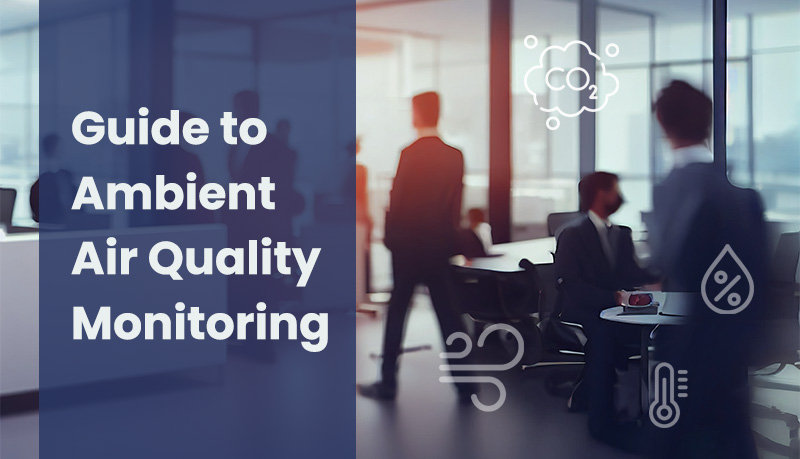Guide to Ambient Air Quality Monitoring: Ensuring Health and Well-being Indoors
As we spend a significant portion of our lives indoors, the quality of indoor air becomes very important to our health and well-being. Understanding and monitoring ambient air quality within indoor spaces is essential for maintaining a healthy environment. In this guide, we will discuss the importance of air quality monitoring, the various types of monitoring methods, and how to measure indoor air quality effectively.
Overview About Ambient Air Quality Monitoring:
Ambient air quality monitoring involves the systematic observation and assessment of air pollutants present in the atmosphere. It encompasses both indoor and outdoor environments, focusing on pollutants such as particulate matter, volatile organic compounds (VOCs), carbon dioxide (CO2), humidity, temperature, and more. By monitoring these parameters, we can gain insights into the overall air quality and take necessary measures to mitigate potential health risks.
Importance of Air Quality Monitoring:
The importance of air quality monitoring cannot be overstated, especially in indoor environments where we spend the majority of our time. Poor indoor air quality can lead to various health issues, including respiratory problems, allergies, and even more severe conditions like asthma. Additionally, prolonged exposure to indoor pollutants has been linked to decreased cognitive function and productivity levels. By monitoring air quality, we can identify sources of pollution, implement effective ventilation strategies, and ultimately create healthier indoor spaces for occupants.
Types of Air Quality Monitoring:
There are several types of air quality monitoring methods, each serving specific purposes and applications:
- Real-time Monitoring: This involves real-time monitoring of air pollutants using sensors and monitoring devices such as HibouAir. Continuous monitoring provides instant feedback on air quality levels, allowing for prompt intervention when necessary.
- Passive Monitoring: Passive monitoring relies on the collection of air samples over a specified period, which are then analyzed. Cloud solution provided by HibouAir’s Smart Analytical dashboard can be effective in passive monitoring. While less immediate than continuous monitoring, passive monitoring offers valuable insights into long-term trends and pollutant concentrations.
- Portable Monitoring: This involves the use of portable devices to assess air quality in various locations. This method is particularly useful for identifying pollution hotspots and assessing air quality in areas not covered by fixed monitoring stations.
Measuring Your Indoor Air Quality:
To measure indoor air quality effectively, it is essential to consider the following parameters:
- Particulate Matter (PM): PM1.0, PM2.5, and PM10 refer to particles of varying sizes suspended in the air. These particles can originate from sources such as combustion processes, dust, and vehicle emissions. Monitoring PM levels is crucial as exposure to fine particles can penetrate deep into the respiratory system, leading to health problems.
- Carbon Dioxide (CO2): CO2 levels are indicative of indoor ventilation and occupancy levels. High CO2 concentrations can indicate poor ventilation, which may result in stuffy indoor environments and increased health risks.
- Volatile Organic Compounds (VOCs): VOCs are emitted by various household products, building materials, and furnishings. Monitoring VOC levels helps identify potential sources of indoor air pollution and assess the effectiveness of ventilation systems in removing these pollutants.
- Temperature and Humidity: Maintaining optimal temperature and humidity levels is essential for comfort and well-being indoors. High humidity levels can promote mold growth and worsen indoor air quality, while extremes in temperature can affect occupant comfort and productivity.
In conclusion, ambient air quality monitoring plays a crucial role in ensuring healthy indoor environments. By understanding the importance of air quality monitoring and utilizing appropriate monitoring methods and devices such as HibouAir, we can take proactive steps to safeguard our health and well-being indoors. Remember, knowledge is key to creating a healthier living and working environment for all.
References:
- WHO guidelines for indoor air quality: selected pollutants
- ASHRAE Standard 62.1-2019, Ventilation for Acceptable Indoor Air Quality
- World Health Organization. Air quality, energy and health.
- U.S. Environmental Protection Agency. Primary Causes of Indoor Air Problems
- Asthma and Allergy Foundation of America. Why Healthy Indoor Air Quality Is Important

